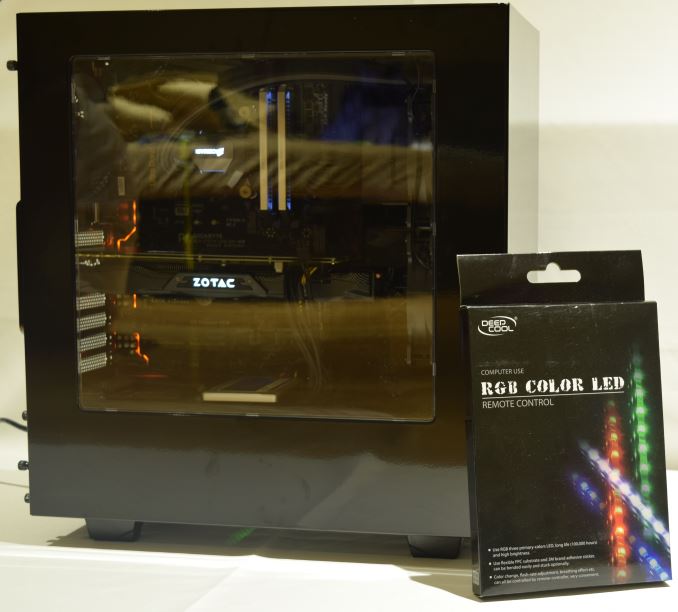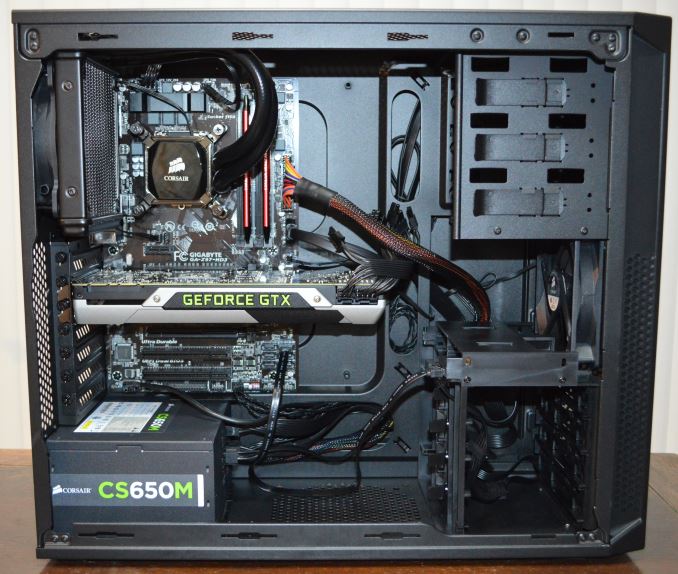Build-A-Rig Round 1, Zotac vs. Corsair: The $1500 PC Build Logs
by Ryan Smith & Ganesh T S on July 30, 2015 3:00 PM EST- Posted in
- Build-A-Rig
- Corsair
- ZOTAC
The End Result
Zotac
For looks and cleanliness, the Zotac system looks significantly better. Aside from the near-black internals accentuated by the lights from the GPU and the DRAM, cable management removes some of the more garish ends of the power supply should someone decide to shine a light in (or the eventual winner uses the LED kit also included in the bundle). A minor concern comes from the extra cable space behind the motherboard tray due to the large extension cables to improve the look, however once installed it becomes a relative non-issue.
Zotac's 'Hey Good Lookin' System (above)
Chinny Chuang and Buu Ly from Zotac (below)
Corsair
In contrast, the Corsair system is the quintessential black-box PC designed to be used, not seen or heard. It can be quite hard to argue with the performance components under the hood, and we expect to see monster performance results, but a box has nothing to show off if the winner wants to take it to LANs or ends up with it on their desk. The danger with a bland machine is putting it on the floor and forgetting about it, allowing dust to build up, whereas a windowed machine at least gets some obvious hint if it needs a cleaning.
Corsair's 'The Accelerator' Build (above)
Dustin Sklavos from Corsair Memory (below)
Performance results are inbound for the final part of Build-A-Rig Round 1, with both of these machines nearing the end of their testing and we will post those results soon.
How to Enter
For Build-A-Rig, we are posting the survey link on each piece so users can enter at any time. The final entry date is August 1st, as the Build-A-Rig challenge is quickly coming to a close..
For the purposes of the giveaways, we should state that standard AnandTech rules apply. The full set of rules will be given in the survey link, but the overriding implementation is that the giveaways are limited to United States of America (US50), excluding Rhode Island, and winners must be 18 years or older.
With apologies to our many loyal readers outside the US, restricting the giveaways to the US is due to the fact that AnandTech (and more specifically our publisher, Purch) is a US registered company and competition law outside the US is very specific for each nation, with some requiring fees or legal implementations to be valid with various consequences if rules aren’t followed. It’s kind of difficult for the rules of 190+ countries/nations worldwide to all be followed, especially if certain ones demand fees for even offering a contest or tax on prizes. We recognize that other online magazines and companies do offer unrestricted worldwide competitions, but there are specific rules everyone should be following in order to stay on the side of the law. That’s the reality of it, and unfortunately we cannot change on this front, even with the help of Purch.
The survey link is:
http://www.surveygizmo.com/s3/2209797/AnandTech-Newegg-Build-A-Rig-Challenge-Sweepstakes-Q2-2015















53 Comments
View All Comments
eek2121 - Thursday, July 30, 2015 - link
I don't understand the component selection for the zotac build. A quick build off from newegg using a the same case, motherboard, same gen graphics card (zotac 970, but a different, cheaper) model, and no water cooling or bling allowed me to significantly up the speed of the overall system. 16 GB of DDR3 1866 RAM, core i7 4790k, Samsung 850 EVO 500 Gb SSD and Windows 10 pro. All for $1431. I wasn't even trying, can probably do even better on Amazon since Amazon tends to be cheaper. You could even go to 32 gb of RAM and not be over budget.atl - Thursday, July 30, 2015 - link
Again - 240mm AIO water cooler on 84TDP non-overclockable CPU, which in RL will most likely not exceed 60 Wattsfokka - Thursday, July 30, 2015 - link
i think it is very likely to exceed 60 watts and even the tdp of 84 watts, since it might use more than that in turbo mode. but as you said, in real life it will only turbo for short periods of time most of the time, so the 240mm cooler is completely over the top of course.arnavvdesai - Thursday, July 30, 2015 - link
Hope to WIN!!Scrote - Thursday, July 30, 2015 - link
So for the Corsair machine, how would one know that the fan headers are running at a lower voltage? Does it show the value as a %? Otherwise, I would have no idea if they're lower than normal or not... if it's just showing a voltage amount, since I don't know the standard amount.fokka - Thursday, July 30, 2015 - link
there might be something like a "silent" or "low" fan mode in bios with the option to override and customize the seperate fan speeds. you'll most likely see a percentage or some other number indicating the speed so it should be relatively straight forward to spot the culprit - if you know what to look for.barleyguy - Thursday, July 30, 2015 - link
Oh, there's a typo on page 2:"there aren’t any major sources of head in this build besides the CPU"'
Well, I assume it's a typo. It does read fine and make perfect sense the way it is. ;-)
MTDEW - Thursday, July 30, 2015 - link
I agree with most other comments here..IMO Corsair nailed it with proper priorities when working with a budget...CPU, Memory, Mobo, PSU and GPU performance are top priority over aesthetics.
Performance per $$ should always take top priority over aesthetics when working within a limited budget.
Add a cheap HDD to the Corsair build and you've got a heck of a lot of PC Gaming performance for your $$$.
Although to be fair, going by the rules Corsair was allowed to come in a little over budget. ;)
wperry - Thursday, July 30, 2015 - link
I'm all in on the Corsair build.....but dude, take 5 minutes to route and tuck the cables - it looks like butt.
Gigaplex - Friday, July 31, 2015 - link
There's only so much routing and tucking that makes sense when the cables don't quite fit nicely in the first place, and the case doesn't have a window to see the diminishing returns.